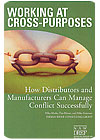
The following is from the Introduction to the book, “Working at Cross-Purposes: How Distributors and Manufacturers Can Manage Conflict Successfully,” available at www.nawpubs.org.
Distributor and supplier relationships are a perennial subject of business executives. Whether at trade conventions or in boardrooms or customers' offices, the topic engenders heated discussions about the problem du jour that usually end with someone saying, “There's got to be a better way!”
These are complex economic relationships between trading partners, and much of the past research on them has been prescriptive rather than diagnostic, focusing on making the relationship work despite the problems instead of trying to find out what went wrong in the first place or why. Clearly, distributors and suppliers have common ground. Their relationships must be based on mutual trust, they need to have honest and candid communications, and they both have to continue to grow.
So, with all these mutual interests, what is behind the constant friction?
Getting Some ANSWERS
A new book titled, “Working at Cross-Purposes: How Distributors and Manufacturers Can Manage Conflict Successfully,” can help readers understand what really drives distributor-supplier relationships, how often they go bad and why. It also offers advice on how to move a distributor-supplier relationship from dysfunctional to effective. The book describes the research findings of a project undertaken by the Distribution Research and Education Foundation (DREF).The research project began with 154 responses by wholesaler-distributor executives to a comprehensive written survey about the state of key supplier relationships. Within this group, 71 executives indicated that they had ended a major supplier relationship (voluntarily or involuntarily) within the past five years. Fifty-four of the 71 executives were willing to speak candidly about their experiences; however, they were not comfortable being identified by name because such disclosure might pose at least some risk in terms of potential litigation or lost competitive advantage.
These discussions turned into telephone interviews that averaged 90 minutes in length. Additionally, the authors conducted interviews with 11 suppliers who were parties in one of the 54 termination experiences described in the interviews with the executives.
The research set out to discover if a means exists to predict if future problems are likely to occur in relationships with a distributor's key suppliers. Furthermore, the research was “future-focused” to see if there was a means of correcting emerging problems before they became critical. Ninety percent of the wholesaler-distributors interviewed had revenues between $5 million and $500 million, and they represented a variety of different trade associations.
LEARNING From The Survey Results
On one level, this is a book about treachery and deceit (on both sides), as there is high emotional content in the stories. At another level, it is a book about missed opportunities. When the authors asked the initiator of the termination if the other party was surprised when learning about the decision, the typical response was, “They were very surprised, but I don't understand why because we kept sending clear messages and they just wouldn't listen!”This response was the first key to understanding the findings of the DREF study: Messages were being sent by one party but not received by the other, leading to expensive and costly changes. Perhaps some of these changes were actually avoidable by either the supplier or the wholesaler-distributor. What would happen if the clarity of message sending could be improved? What would happen if the sensitivity of the receiver could be improved? There is some truth to the old adage that the only thing worse than hearing the alarm clock in the morning is not hearing it.
As the authors analyzed the survey responses and interview findings, they discovered two laws that shaped the recurring issues and crises. “Laws” might be too strong a word, but the consistency of the miscommunication was very surprising. The same patterns kept surfacing. Understanding the influence of these two laws would have avoided emotional tension, most of the cost of being ineffective, and almost all of the terminations. They are the Law of Legitimate Cross-Purposes and the Law of Perpetual Change.
The LAW Of Legitimate Cross-Purposes
Hard to imagine, perhaps, but win-win is dead. To the extent that they ever existed, the days of shared prosperity are over. Distribution businesses and manufacturing businesses work at legitimate cross-purposes because their paths to profit and growth are very different.There are certainly co-dependent aspects that warrant collaboration, but these aspects only represent a portion of the relationship. There are aspects where individual best interests are actually in conflict when considering the long-term interests of the respective shareholders.
Suppliers and distributors often are very reluctant to discuss these inherent conflicts as they focus on the positive areas of congruence.
To be successful, however, companies must recognize and manage these differences. Failure to do so is one of the root causes of many of the destructive relationships explored in this study.
The LAW Of Perpetual Change
Distributors choose the best suppliers available to create their ideal customer offering. Suppliers work hard to build a distribution channel that meets their needs. But, once these relationships are created and aligned to the needs of the parties involved, they immediately start becoming dysfunctional. The reasons are varied. For example, suppliers add new products that create conflicts with other distributor/supplier relationships. Distributors expand or acquire new geography where the supplier already has adequate distribution. These are but two situations that create conflict and small amounts of dysfunction. Both parties require growth, but the methods themselves create conflict.
Resolving these situations as they arise often creates short-term revenue losses. Most distributor- and supplier-executives choose not to hurt short-term revenue and instead try to work it out through discussion. This appeasement practice often leads to death by a thousand cuts over a multiple-year horizon. At some point, the channel becomes so dysfunctional that major surgery is required. The reluctance to deal with small conflicts as they arise is the other root cause of the destructive relationships explored in this study.
How The BOOK Is Structured
The study's findings are concrete and highly actionable, thanks to the candor and honesty of the unnamed executives. These were forensic interviews during which the executives described what had occurred during a prior situation. Once the facts of the situation were clarified, the authors asked the executives to apply their learned experience and 20-20 hindsight to the situation. What signs were present that they ignored at the time? What mistakes did they make in the process? What would they do differently in the future? Their answers are the basis for this book.The book is divided into three sections to provide a framework for action. The first section comprises two chapters that detail the traditional roles of distributors and suppliers, and describe how they are continuing to change. Since 1982, DREF has published primary research every three years on the wholesale distribution industry under the title, “Facing the Forces of Change.” These studies provided an information-rich history of traditional distributor-supplier relationships and how they started unraveling over time. Wholesale distribution has always been in a state of evolution and change. There is no reason to expect this will be different in the future. Wholesaler-distributors are not going away; they will continue to rise in importance and relevance within the supply chain.
The second section explores the economic aspects of the distributor/supplier relationship. At some level, it is all about the money. The relationship is very good when both the supplier and the distributor are growing and making money. One term that has been heavily used recently is “partnership.” Suppliers often say, “Our distributors are not customers, they are our channel partners.” Although the sentiment is nice, the DREF research found that the charming words often disguised long-term rising frustration and dysfunction. The three chapters in this section improve the precision needed to understand the economics underpinning the distributor-supplier relationship.
The final section is about avoiding the missed opportunities that exist in every distributor-supplier channel. This section explores real diagnostic and potentially corrective actions. There are no silver bullets here, but there is the distilled wisdom of the interviewed executives on their lessons learned.
After all the interviews, analysis and all of the hours of discussion, it turns out that effective distributor-supplier relationships require much more than a fancy trade show hospitality suite with jumbo shrimp. They require trust, effective communication, and continuing growth. These three factors are critical for success in the traditional roles of distributors and their suppliers. It is important to understand clearly these traditional roles before trying to make sense of structural conflicts.
As part of the National Association of Wholesaler-Distributors (NAW), DREF sponsors and disseminates research into strategic management issues affecting the wholesale distribution industry. The book is available at www.nawpubs.org. For more information, visit www.naw.org.

